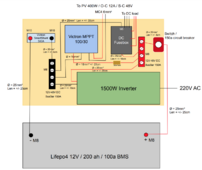Hello !
I am planning a solar system for my van (mainly for charging phone/laptop a water pump, and a few LED lights).
After doing a lot of research, I have come up with the following system :

Does this look ok ? Would you do anything differently ?
(This is my first ever build and I am not very sure of myself - I am kind of hoping if anyone has any advice now - before buying anything - in case my design needs changing...)
And my main question is regarding the cable sizes : Do they respect the (EU) norms for this size system? (ie 25mm² everywhere except to/from the MPPT which supports 16mm² max)
The cable sizes seem a bit overkill to me, given my usage (I guess 99% of the time used I will be drawing 3 to 4 amps for charging phone / laptop)
Still, the battery supports 100a max discharge, so I would like to keep the possibility to use the occasional 1000W appliance (blender or whatever).
Also, does this system require an earth ? and if so how would one go about earthing in a van? I know the vehicle electronics are/may be grounded to the chasis. If I also ground to the chasis couldn't that damage the inbuilt vehicle electronics in case of short-circuit ?
Any advice much appreciated

I am planning a solar system for my van (mainly for charging phone/laptop a water pump, and a few LED lights).
After doing a lot of research, I have come up with the following system :

Does this look ok ? Would you do anything differently ?
(This is my first ever build and I am not very sure of myself - I am kind of hoping if anyone has any advice now - before buying anything - in case my design needs changing...)
And my main question is regarding the cable sizes : Do they respect the (EU) norms for this size system? (ie 25mm² everywhere except to/from the MPPT which supports 16mm² max)
The cable sizes seem a bit overkill to me, given my usage (I guess 99% of the time used I will be drawing 3 to 4 amps for charging phone / laptop)
Still, the battery supports 100a max discharge, so I would like to keep the possibility to use the occasional 1000W appliance (blender or whatever).
Also, does this system require an earth ? and if so how would one go about earthing in a van? I know the vehicle electronics are/may be grounded to the chasis. If I also ground to the chasis couldn't that damage the inbuilt vehicle electronics in case of short-circuit ?
Any advice much appreciated
Last edited:


